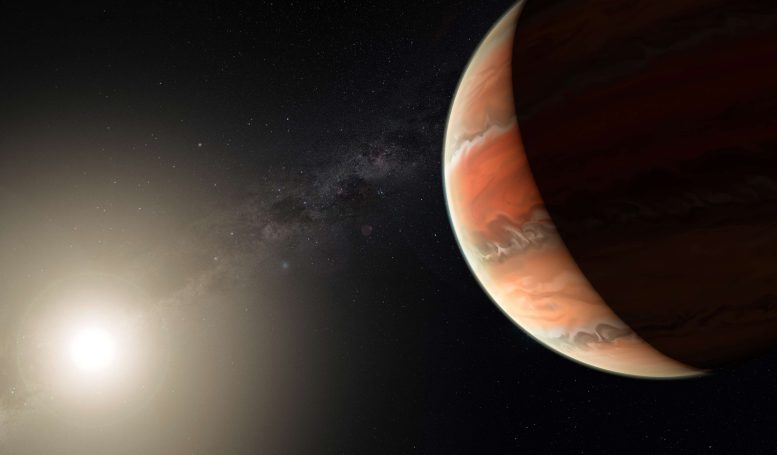
An artist’s impression showing the exoplanet WASP-19b. Credit: ESO/M. Kornmesser
The last decades of “exoplanet hunting” – the search for planets orbiting stars other than the Sun – have allowed us to better understand the evolutionary paths leading to the current architecture of our planetary system as well as of other discovered systems. To date, the discovery of 4715 exoplanets belonging to 3247 planetary systems has been confirmed, and there are approximately 5900 planets awaiting confirmation.
Strikingly, the architecture of our Solar System seems to be very different from the configurations found in other systems in the galactic neighborhood; for example, a significantly high proportion of massive Jupiter-like planets have been discovered orbiting in regions very close to the star, opposed to what planetary formation models indicate: giant planets should form in the most peripheral regions of the protoplanetary disc.
It is worth noting that the apparent overabundance of such planets is related to an observational bias: the sensitivity of the devices used for the detection of exoplanets is limited, and for now they are just able to recognize with greater ease the most notorious exoplanets; that is, large planets (in mass and size) orbiting very close to their star. These characteristics guarantee that they eclipse a large area of the stellar disk when the planet crosses in front of the star, in addition to giving a good gravitational pull to the star that we can detect by measuring the radial velocity of the star. In any case, this population raises important questions about how these architectures were formed, and what will be the fate of these exoplanets with very short orbital periods.
Regarding the above, a recent research led by the PhD candidate Jaime A. Alvarado Montes from the Centre for Astronomy, Astrophysics and Astrophotonics at Macquarie University in Australia, has studied the fate of a subcategory of these anomalous planets known as “ultra-short period planets” (USP). These planets orbit their star in times shorter than one Earth day in nearly circular orbits, and are possibly tidally locked, i.e. always showing the same face to the star throughout their orbit, just as our Moon does with respect to the Earth.
The study, which has recently been accepted for publication in the prestigious journal Monthly Notices of the Royal Astronomical Society (MNRAS), updates pre-existing models describing the tidal interaction between the planet and the star. This research studies the force generated by the mutual deformation experienced by the bodies as a result of their gravitational interaction, as they rotate, move, and age. Ultimately, the goal is to constrain the rate at which the orbits of the USPs shrink (the planet is said to be migrating) until they are engulfed by their own stars or disrupted by gravitational forces.
“The research carried out so far shows that tides can significantly or radically modify the architecture and possible fates of planetary systems.”
According to Alvarado-Montes, leader of the project, “Modeling the rate at which exoplanets migrate provides us with better predictive models to know the fate of these exoplanets. Such models can become increasingly complex as we have to account for several effects related to the star and the planet. These effects can be related to changes in the planetary rotational rate, the efficiency in dissipating the energy associated with the deformations of the star and the planet along with their mass loss, and the magnetic field of the star. To date, we have had powerful instruments that have been monitoring some of these exoplanets for decades, taking measurements of the variations of their orbital periods. Those measurements, interpreted with models such as the ones presented in this research, can indirectly reveal the interior structure of planets and stars, showing details of the physical processes responsible for planetary migration”, adds Mario Sucerquia, co-author of the research.
In particular, the work presented predicts a progressive shift of the transit periodicity of two massive USP exoplanets, WASP 19b, and NGTS 10b, objects that orbit their star once every 20 hours or so. These periods indicate that they are located at very close distances to their star, so their surface temperatures are extremely high. Also, the model of this work predicts a higher orbital migration rate for the former and a lower one for the latter, when compared to previous similar investigations. These predictions could be corroborated during the current decade.
The study in question is part of a large ongoing project involving researchers from Australia, France, Colombia, Argentina, and Chile, which aims to study the phenomenon of gravitational tides in planetary systems. This phenomenon affects not only planets and their stars, but also their possible systems of moons and rings. According to the authors of this article: “the research carried out so far shows that tides can significantly or radically modify the architecture and possible fates of planetary systems. Furthermore, this type of studies can help us understand the future of planets like Jupiter in our Solar System, since when the Sun will increase its size in the final stages of its life, Jupiter will eventually become a short-period planet, and tidal interactions will be much more intense, thus affecting its fate and the possible habitability of its moons.”
Reference: “The impact of tidal friction evolution on the orbital decay of ultra-short-period planets” by Jaime A Alvarado-Montes, Mario Sucerquia, Carolina García-Carmona, Jorge I Zuluaga, Lee Spitler and Christian Schwab, 19 April 2021, Monthly Notices of the Royal Astronomical Society.
DOI: 10.1093/mnras/stab1081









Be the first to comment on "Unveiling the Fate of Ultra-Short Period Exoplanets"